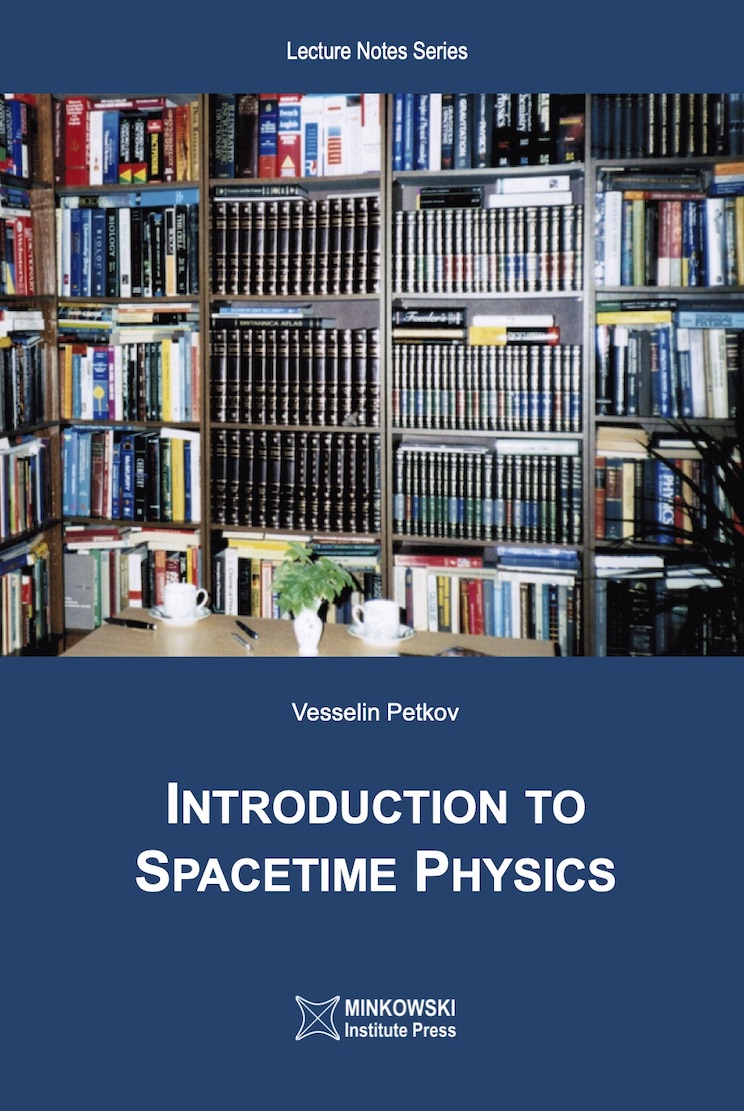 |
Vesselin Petkov, Introduction to Spacetime Physics
(Minkowski Institute Press, Montreal), 250 pages (Lecture Notes Series, Volume 8).
ISBN: 978-1-927763-21-6 (ebook) - $7
ISBN: 978-1-927763-08-7 (softcover) - $18
ISBN: 978-1-998902-41-5 (hardtcover) - $26
Will appear in 2024
|
Description:
This textbook is built up from course notes on special relativity which was part of an advanced undergraduate course regularly given at the Physics Department of Concordia University in Montreal and from notes used in a one-semester inter-university seminar on general relativity for advanced undergraduate and graduate students, which was given twice - in the fall semesters of 1994 and 1995 - and attended mostly by graduate physics and mathematics students (and several colleagues) from the four Montreal Universities.
The major feature which makes this book fundamentally different from the existing textbooks on the subject is that by
strictly following Minkowski's program of geometrizing physics, gravitational phenomena are shown to be nothing more than manifestations of the non-Euclidean geometry of spacetime, not manifestations of a physical (gravitational) interaction. It is stressed that the profound physical meaning of Einstein's general relativity is that gravitation is not a physical interaction (as Minkowski, had he been alive in 1915, would have probably demonstrated, and as in 1921 Eddington even mentioned it explicitly - "gravitation as a separate agency becomes unnecessary") and therefore no gravitational energy and momentum are involved in gravitational phenomena. It is consistently demonstrated in the book that, indeed, all gravitational phenomena are mere effects of the curvature of spacetime (without assuming any gravitational interaction) and no gravitational energy and momentum are used in the derivations of the predictions of general relativity.
Another distinct feature of the textbook is that it follows the opposite of the (in)famous "shut up and calculate" methodology (designed to suppress questions about open questions in quantum physics in order to make its very learning possible) -- it follows an approach which clearly puts the emphasis on the physics behind the mathematical formalism. This approach enables students to overcome the conceptual challenges of understanding the counter-intuitive properties of spacetime and to prepare them for more advanced courses on the subject. The main idea is to ensure that students have perfect understanding of what they calculate. Another advantage of this approach is that it also enables students to deal adequately and confidently with misconceptions and controversies in spacetime physics, e.g. the controversy over (rather the assault on) the concept of relativistic mass and the question of whether general relativity predicts the existence of singularities inside black holes (a question recently revived by Roy Kerr [On 1 December 2023 Roy Kerr (who discovered the Kerr geometry of a rotating black hole) posted a very important paper "Do Black Holes have Singularities?" (arXiv:2312.00841[gr-qc]) where he demonstrated that "There is no proof that black holes contain singularities when they are generated by real physical bodies."].
As this textbook does not require previous knowledge beyond calculus and as all new physical concepts and mathematical formalism are gently introduced, it can be also used for self-study by anyone interested in the amazing physics of spacetime and its implications.
The textbook includes 7 appendices and a Glossary:
H. Minkowski, Space and Time (Minkowski's groundbreaking lecture)
Relativistic Mass is an Experimental Fact
Accelerating Spaceships Paradox and Physical Meaning of Length Contraction
Propagation of Light in Non-Inertial Reference Frames
Acceleration is Worldline Curvature (in flat and curved spacetime)
Common Misconceptions in Spacetime Physics
Open Questions in Spacetime Physics
Glossary
|